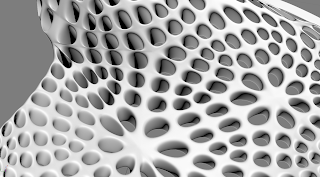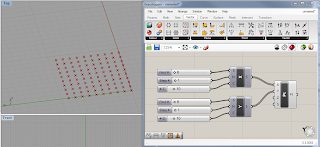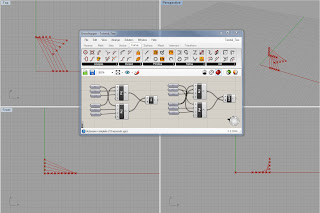Wednesday
Above is my final flowgraph model which contains 4 main clusters of nodes that can vary the overall output of the model.
- The top left group contains a WeaverBird Prism (wbPrism) which begins the modelling process by creating a shape of which to work off. I have attached three sliders to the prism varying the number of sides in the prism, the size of the prism and the levels or section lines within the prism.
- Below this is a Point Grid node (pComp) which uses the output of a RecGrid and feeds it into pComp - decomposing those points into component parts, which have then created the points using those (x,y) coordinates.
- I then wanted to create multiple curves that connect the points in the x or y direction. Ultimately creating a set of curves that will bend based on point attractors. The at the bottom left contain this. I created four curves with a number slider for each curves x and z output. As well as this I made two number sliders that link the y axis of each curve together.
- The group on the top right is the main output cluster. This group contains a Weaverbird Frame tool where the slider varies the edge count, resulting with each new face containing a new hole forming a mesh type form. A Weaverbird Thicken tool attached to a multiplier changes the thickness of the strands in the mesh form.
I have decided to change my Theme for the basis of my assignment. This is because I have learnt how to use new grasshopper tools as well as Weaverbird (plug-in) that I feel would be better suited to a more organic free flowing surface. I therefore want to create a parasitic model that grows and multiplies during its existence creating layers of organic forms as it branches.
My conducted research is based upon Cancer, more specifically "Soft Tissue Sarcoma" which develops from soft tissues like fat, muscle, nerves, fibrous tissues, blood vessels, or deep skin tissues. The reason for choosing this is that it can be found in all parts of the body and its ability to spread and multiply is therefore exceptionally dangerous.
The organic curves and voids within the stringy, rubbery tissue is something I believe I can achieve in grasshopper and in doing so, create an aesthetically pleasing, unique model.
My conducted research is based upon Cancer, more specifically "Soft Tissue Sarcoma" which develops from soft tissues like fat, muscle, nerves, fibrous tissues, blood vessels, or deep skin tissues. The reason for choosing this is that it can be found in all parts of the body and its ability to spread and multiply is therefore exceptionally dangerous.
The organic curves and voids within the stringy, rubbery tissue is something I believe I can achieve in grasshopper and in doing so, create an aesthetically pleasing, unique model.
First Attempt at creating a spider web type form in GH
Here I used random modifiers along with a Pop3D, Point, Line and Sphere tools to create a web-like form. The slider on the very left varies the amount of spheres and consequently lines within the model. The other slider varies the number of points within the model creating random clusters.
Inspiring Tutorial
Whilst doing a bit of research on my desired "theme" (spider webs) I came across this tutorial on creating Hexagonal Meshes in Grasshopper. I found this to be a go way of developing my model and whilst playing around in grasshopper came up with some pretty cool stuff. One thing I would like to do differently however is to create a little bit more randomness within its form which I have yet to figure out how to do.
Here is the tutorial:
Here is the tutorial:
Inspiration for project work
Whilst reading the paper today I came across an article about how thousands of spiders within the town of Wagga Wagga have looked for higher ground to avoid the large rainfall and have consequently created mass webs across sticks and bushes. Looking at the photos of this I became inspired by the variety of shapes and randomness of the patterns they create. Here are some photos from the article:
Tuesday
The radial sequenced patterns found within a flower almost seem as though they are not random at all.
The randomness of finger print patterns... No two people have the same finger print.
The parasitic nature of Cancer is quite inspiring as it multiplies and branches to expand all throughout the human body.
The variations in size and layouts of spider webs could be a great theme for conducting a model.
Week 1 tutorials
As this is the first time I have used Rhino and Grasshoper I spent quite a long time going through the tutorials and trying to get my head around this different type of modelling. I have done alot of modelling using other programs however I found this to be the most difficult to understand. The screenshots show my progress in learning the fundamental tools and rules of Grasshopper. My explorations didn't seem to get very creative or far as I still do not quite understand how to go about modelling.
Subscribe to:
Comments (Atom)











































